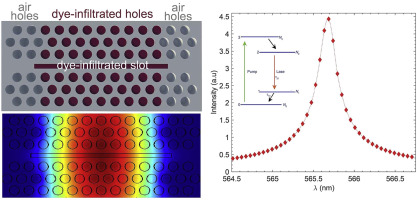Organic Electronics ( IF 2.7 ) Pub Date : 2017-12-29 , DOI: 10.1016/j.orgel.2017.12.040 Mohammad Hazhir Mozaffari , Majid Ebnali-Heidari , Gholamreza Abaeiani , Mohammad Kazem Moravvej-Farshi

|
Optofluidic biolasers indicate promising potential and properties that make them highly competitive in the development of state-of-the-art biophotonics technologies. One of the bright outlooks and perspectives that could have a profound impact on the current developing situation and trend of such a new found technology is the photonic crystal based optofluidic biolaser. In this article, we theoretically propose a new lab-on-a-chip design of slotted photonic crystal optofluidic biolaser. Within this scheme, the air slot and medial air holes of the miniaturized photonic crystal slab are infiltrated with organic dye solution, acting as the laser gain region. This structure provides a facility for incorporation of the biological molecules in those fluidic gain mediums. Simulations show that, in addition to the proper lasing characteristics, like the spectral linewidth of 0.27 nm and power conversion efficiency of 26%, the proposed device is highly sensitive to the subtle biological changes that may occur in its cavity and shows the sensitivity of 277 nm/RIU.
中文翻译:

设计用于芯片实验室生物传感应用的基于光子晶体的微型光流体生物激光器
光电流体生物激光器显示出令人鼓舞的潜力和特性,使其在最先进的生物光子技术的开发中具有很高的竞争力。可能对这种新发现的技术的当前发展状况和趋势产生深远影响的光明的前景和观点之一是基于光子晶体的光流体生物激光。在本文中,我们从理论上提出了缝隙光子晶体光电流体生物激光器的新型芯片实验室设计。在该方案中,小型化的光子晶体平板的气隙和中间的气孔被有机染料溶液渗透,用作激光增益区域。这种结构提供了将生物分子掺入那些流体增益介质中的便利。仿真表明,除了适当的激光特性外,







































 京公网安备 11010802027423号
京公网安备 11010802027423号